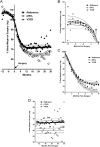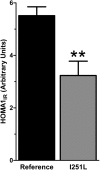The MC4R(I251L) allele is associated with better metabolic status and more weight loss after gastric bypass surgery
- PMID: 21976721
- PMCID: PMC3232628
- DOI: 10.1210/jc.2011-1549
The MC4R(I251L) allele is associated with better metabolic status and more weight loss after gastric bypass surgery
Abstract
Context: Factors that influence long-term weight loss after Roux-en Y gastric bypass (RYGB) surgeries are poorly defined. The melanocortin system plays an important role in regulating energy homeostasis, satiety, and glucose metabolism. Variations of the MC4R comprise the most prevalent monogenetic obesity disorder.
Objective: The objective of the study was to examine the role of MC4R variants and diabetic status in long-term weight loss after RYGB.
Participants and methods: In 1433 extremely obese patients who underwent RYGB, we sequenced for genetic variants of MC4R. We examined the MC4R genotype and its relationship with weight loss profile, and clinical phenotypes accumulated during a 48-month period before and after surgery.
Results: We found 80 subjects with rare and common variants of MC4R in the RYGB cohort. Among these, 26 and 36 patients carry the I251L and V103I variants, respectively. These common alleles are negatively associated with obesity. Remarkably, after the 12-month presurgery caloric restriction and RYGB, I251L allele carriers lost 9% more weight (∼9 kg) compared with the noncarriers, continued rapid weight loss longer, regained less weight, and had lower presurgery homeostatic model assessment for insulin resistance values. Normoglycemic, I251L allele carriers lost more weight compared with their diabetic and prediabetic counterparts and maintained their weight loss. Among noncarriers, normoglycemic individuals initially lost more weight compared with dysglycemics, but this difference was not maintained in the long term.
Conclusions: Individuals carrying the I251L common allele are predisposed to better clinical outcome, reduced risk of type 2 diabetes, and better weight loss during diet and surgical interventions. Diabetic status has only a small, short-term effect on weight loss after RYGB.
Figures



Similar articles
-
Long-term weight-loss in gastric bypass patients carrying melanocortin 4 receptor variants.PLoS One. 2014 Apr 4;9(4):e93629. doi: 10.1371/journal.pone.0093629. eCollection 2014. PLoS One. 2014. PMID: 24705671 Free PMC article.
-
Weight-independent effects of roux-en-Y gastric bypass on glucose homeostasis via melanocortin-4 receptors in mice and humans.Gastroenterology. 2013 Mar;144(3):580-590.e7. doi: 10.1053/j.gastro.2012.11.022. Epub 2012 Nov 15. Gastroenterology. 2013. PMID: 23159449 Free PMC article.
-
Mouse models for V103I and I251L gain of function variants of the human MC4R display decreased adiposity but are not protected against a hypercaloric diet.Mol Metab. 2020 Dec;42:101077. doi: 10.1016/j.molmet.2020.101077. Epub 2020 Sep 9. Mol Metab. 2020. PMID: 32916307 Free PMC article.
-
Treatment options for children with monogenic forms of obesity.World Rev Nutr Diet. 2013;106:105-12. doi: 10.1159/000342556. Epub 2013 Feb 11. World Rev Nutr Diet. 2013. PMID: 23428688 Review.
-
Mechanisms of improved glycaemic control after Roux-en-Y gastric bypass.Dan Med J. 2015 Apr;62(4):B5057. Dan Med J. 2015. PMID: 25872541 Review.
Cited by
-
Randomized double-blind placebo-controlled study of leptin administration after gastric bypass.Obesity (Silver Spring). 2013 May;21(5):951-6. doi: 10.1002/oby.20433. Obesity (Silver Spring). 2013. PMID: 23512892 Free PMC article. Clinical Trial.
-
Melanocortin-4 receptor mutations and polymorphisms do not affect weight loss after bariatric surgery.PLoS One. 2012;7(11):e48221. doi: 10.1371/journal.pone.0048221. Epub 2012 Nov 21. PLoS One. 2012. PMID: 23185251 Free PMC article.
-
Neurohormonal Changes in the Gut-Brain Axis and Underlying Neuroendocrine Mechanisms following Bariatric Surgery.Int J Mol Sci. 2022 Mar 19;23(6):3339. doi: 10.3390/ijms23063339. Int J Mol Sci. 2022. PMID: 35328759 Free PMC article. Review.
-
Precision medicine in adult and pediatric obesity: a clinical perspective.Ther Adv Endocrinol Metab. 2019 Jul 27;10:2042018819863022. doi: 10.1177/2042018819863022. eCollection 2019. Ther Adv Endocrinol Metab. 2019. PMID: 31384417 Free PMC article. Review.
-
Bile Acids, FXR, and Metabolic Effects of Bariatric Surgery.J Obes. 2016;2016:4390254. doi: 10.1155/2016/4390254. Epub 2016 Feb 24. J Obes. 2016. PMID: 27006824 Free PMC article. Review.
References
-
- Fontaine KR, Redden DT, Wang C, Westfall AO, Allison DB. 2003. Years of life lost due to obesity. JAMA 289:187–193 - PubMed
-
- Robinson MK. 2009. Surgical treatment of obesity—weighing the facts. N Engl J Med 361:520–521 - PubMed
-
- Goldfine AB, Shoelson SE, Aguirre V. 2009. Expansion and contraction: treating diabetes with bariatric surgery. Nat Med 15:616–617 - PubMed
-
- Kruseman M, Leimgruber A, Zumbach F, Golay A. 2010. Dietary, weight, and psychological changes among patients with obesity, 8 years after gastric bypass. J Am Diet Assoc 110:527–534 - PubMed
-
- Barsh GS, Farooqi IS, O'rahilly S. 2000. Genetics of body-weight regulation. Nature 404:644–651 - PubMed
Publication types
MeSH terms
Substances
Grants and funding
LinkOut - more resources
Full Text Sources
Other Literature Sources
Medical
Research Materials

